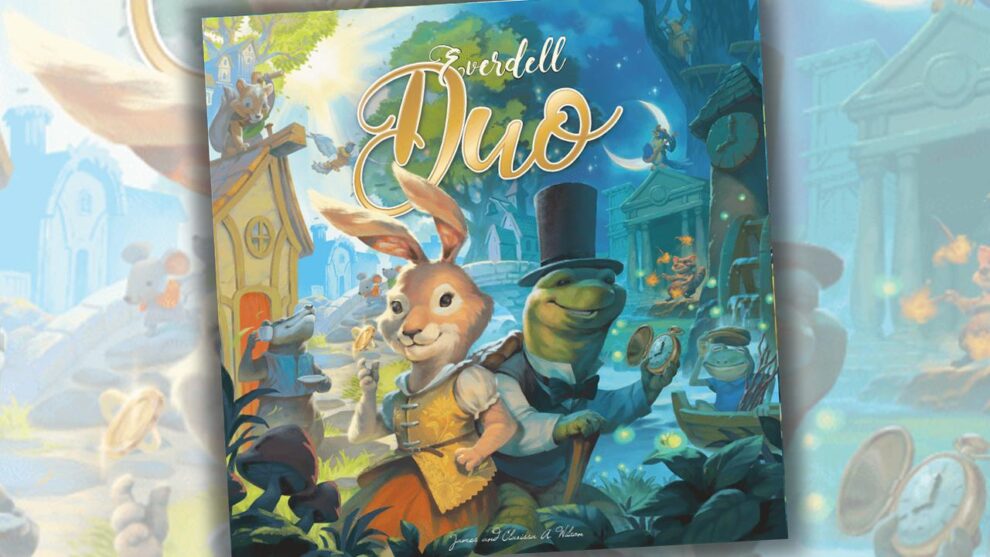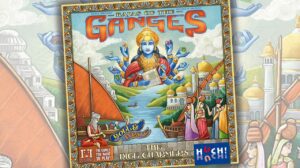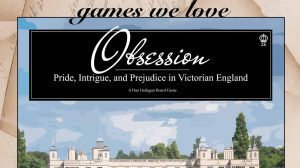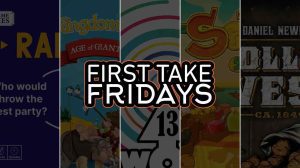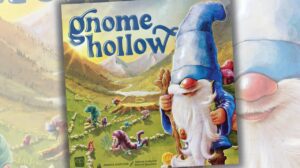Disclosure: Meeple Mountain received a free copy of this product in exchange for an honest, unbiased review. This review is not intended to be an endorsement.
Over the years with Everdell, I’ve gone through phases. I’ve run through the expansions, ranking every Everdell experience along the way. I’ve played with my kids regardless of age, introducing even the youngest through My Lil’ Everdell. I’ve played with friends—I’ve even played Everdell digitally. I’ve explored strategies for my favorite tabletop world and I’ve followed that world to new edges of the map with the release of Farshore.
Most recently, I’ve settled into two-player outings with my elder daughter. She has an enthusiasm for Everdell that rivals mine and I cherish the chance to play together. I was immediately intrigued, then, when I found the announcement for Everdell Duo. I think it’s safe to say most players most enjoy Everdell as a duel. Sprawling table presence and ballooning downtime tend to keep the smaller, tighter experience appealing. The upcoming campaign is obviously hoping to scratch a developed itch and maybe rake in the folks on the fringes of the Meadow.
With the rise of two-player versions, it seems everyone is out to streamline and redefine stellar gaming experiences. What changes have James and Clarissa Wilson brought to this newest iteration of my favorite game? Are they refreshing? Worthwhile? I surprised myself a little with my answers.
Remarkably familiar
Everdell Duo will strike all the familiar chords for fans of the base game, but it’s the differences that shine. Over four seasons, players have three workers to send out to various locations for resources and actions—four are static, two change with every season. The aim is to play a city of cards, each unleashing benefits ranging from immediate to worker-triggered to endgame. Sounds familiar.
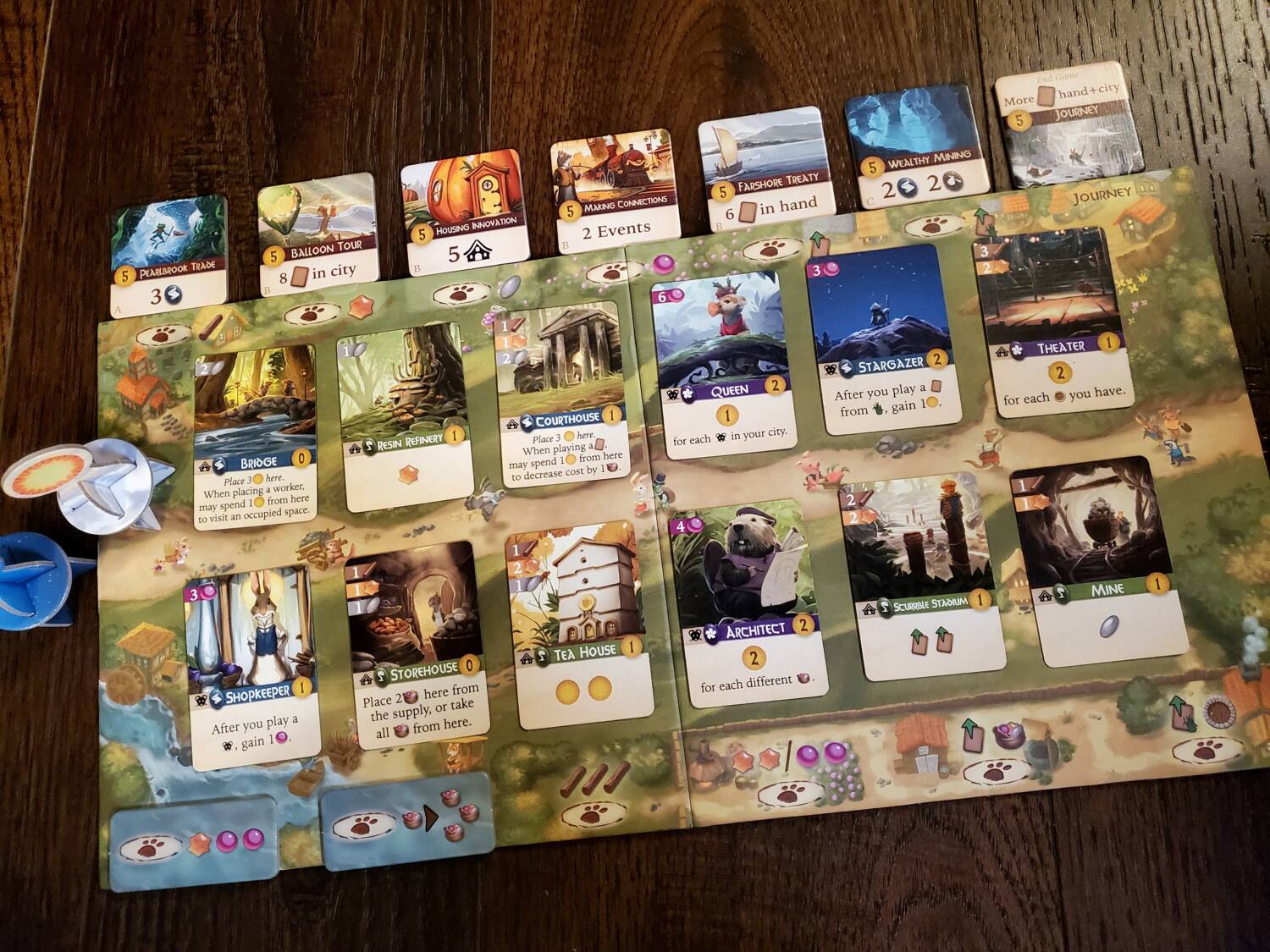
The meadow is a 12 card road, split six cards aside. With each worker placement, a 3D sun moves on down the road to an intersection of two or four cards. With each card play, a 3D moon does the same. The standees semi-restrict card play from the meadow—cards are only available to play if they are in contact with one or both of the tokens. They also serve as timers for the seasons. When they reach the end, it’s time to prepare for the next season.
The same five card types drive the action of building the cities. Some of the cards are direct matches for the base game. Others are reimagined, either for their cost, their benefit, or both. The cards span the various Everdell expansions, bringing the entire world to bear on this iteration.
Across the top of the board are six events, objectives that provide direction and motivation. They are all attainable and provide a direct source of tension between the players. Some are dependent on creating a particular advantage, others on reaching milestones within the city. They are the most efficient source of points as well. As a cherry on top, the worker spots for gathering these tiles also provide a designated resource. The final Journey tile is a comparison of total cards in city and hand.
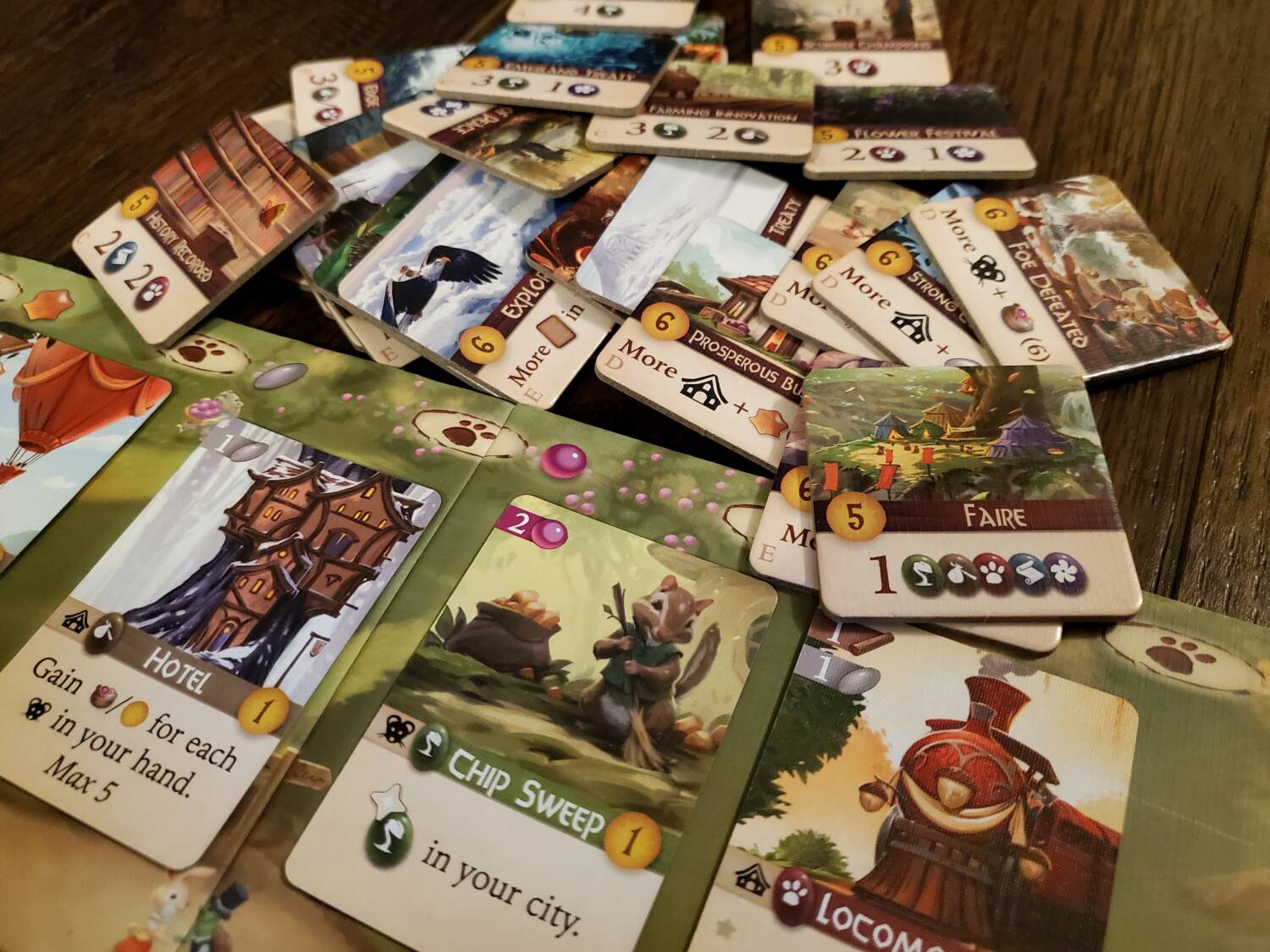
Players assume the role of the Tortoise and the Hare. Each of the rounds is set up to grant a boon—different for each player—and determine the shifting player order. The game has a lovely rhythm and clear markers. In fact, I would say the entire package here is built for easy entry.
One of the best decisions, one that has evolved over the course of Everdell’s existence, is the conversion of the occupied token to a resource. In the earliest versions, these tokens matched the various constructions with specific critters, allowing the free addition of the critter. I think this design decision has generated the most ire with the base game because it creates a dependency on matching cards you might never see. Here, now, the tokens can match any critter of a like color/type. Better yet, they are obtained via worker placement spots and cards, just like twigs and squishy berries (still my favorite component of all time).
Regarding the cards, there are still a lot of cards involved in Everdell Duo. If there is a barrier to entry, it is the sheer number of options that slowly leak into the mix. Twelve visible cards in the meadow. A hand of two that grows to many more, and a bevy of choices. Even sol, I think this is a relatively easy barrier to overcome. The cards are simple, clearly designed, beautiful, and uncluttered. The art is significantly recycled, but the world is the world. I never grow tired of the art that was born of Andrew Bosley’s original style.
One more ‘want’ checked off
Campaign? CAMPAIGN!? Yes, it’s safe to say I’ve harbored an interest in Everdell putting its lore to use in a campaign—one way or another. Everdell Duo not only offers a campaign, but provides for both solo and cooperative play.
The campaign introduces a Skunk, Lily Thorn, a reporter for The Root. The story behind the campaign is that two rival mayors are actually planning a single city—together. The media is sticking its nose in your business, generally disrupting life. (Obviously a far-fetched fantasy) The skunks take up space on the road, among the resources, and even among the events. As a result, players find their intentions choked of all ease while they strive to make their ambitious plans work.

The campaign is a series of challenges that stir the pot beyond just blocking placement sites. Sometimes players will seek large collective objectives. Sometimes players will work individually to bring specific constructions or critters to the new city. Sometimes work needs to be completed by seasonal deadlines. All along the way, the board state is in flux, the skunks are running amok, and players have work to do.
Here’s what I love about the campaign—I lost the first game. Everdell is among the games I feel I know very well. There was enough in the first challenge to keep me scratching my head, trying to find a way. Granted, I played with my eleven-year-old son, but he knows the game. We lost by three points. Looking back over the scene, we realized we had an opportunity to pull it off, but we were hoping to hold onto something for the next game in the campaign. Turns out we shouldn’t have been so stingy. All this to say, the campaign is challenging, but not impossible. Best yet, it tells a story with characteristic Everdell charm.
Brace myself
When Everdell Farshore dropped not long ago, I wasn’t entirely sure what to think. As I said, I think the game is fantastic, but there are just other things I wanted. Everdell Duo is one of those things. I love the campaign mode. I love chasing a story. I would happily dive into a full-on legacy campaign with stickers and weird boards and new characters. But I think this campaign mode scratches a felt itch. I’m not typically a cooperative player, but I think that endeavor sings.
Even more shocking, I’ll say one more thing: If you don’t own Everdell, especially if you are more regularly a two-player gamer, you should buy Everdell Duo instead of my favorite game ever. As a two-player game, it’s really good. Really good. What’s more, it’s still Everdell.
Duo is a more direct, head-to-head affair. The sun and moon mechanic introduces a fantastic tension. It is now possible to influence the timing and use of your opponent’s critter meeples, cards, and resources beyond what the base box offers. You have no choice but to be attentive. Because the celestial tokens affect the cards that are available to play, there is now also a more palpable element of timing at work. The events are similarly a lively race, and the bonus resource there is a fantastic consideration. Every mechanical decision in this box captures the essence of the game with clarity and crunch.

Looking over the component list, there are 30+ event tiles listed. My copy had around 20, so I am excited to see how else the game might send me off in search of victory. Honestly, there’s already enough there to keep me busy awhile, so fifty percent more hot pursuits should only add depth of experience.
The only real complaint that surfaced in playing with the prototype was rooted in the fact that it was a prototype. The sun and moon were drastically over-sized for the game setup, but I understand they will not be so in the finished product. The remaining product, even in its early phases, possesses all the best of Everdell‘s earthy goodness.
The Wallet
For those who don’t own a game in the Everdell line, I say grab a partner and start here. Everdell Duo is a streamlined masterpiece and a great way to greet the world. It’s lighter than the original, heavier than My Lil’ Everdell, and less niche than Everdell Farshore. It’s the sweet spot. And the initial crowdfunding campaign price is absolutely worthwhile.
For those who already own the game, I think the decision is a bit more complex. The changes introduced are not the sort that can simply be implemented into the base game without a purchase. The sun/moon, the road, and the events are unique enough that it would take some work to try to play this iteration without the new box. Not to mention the cards have changed enough that the balance would be off. Plus, the campaign. If you love Everdell, and especially if you love the duel, I think there’s a lot to love here. It’s a smaller box, easier to cart around. Conversely, it might be small enough to squeeze into a product you’ve already purchased and carry around (Bob looks in the mirror and begins analyzing his custom setup with visions of squeezing).
I also think there’s enough of a difference that it could convince some of the game’s detractors. The Wilsons have been flexible across the game’s history. Several design changes have seeped into the heart of Everdell for the better, and they are alive and well in Duo. Those changes have provided a new baseline for the additional ideas.
I’m more excited about this one than even I thought I’d be. The campaign is already live and quite successful. I believe the hype is deserved here.


